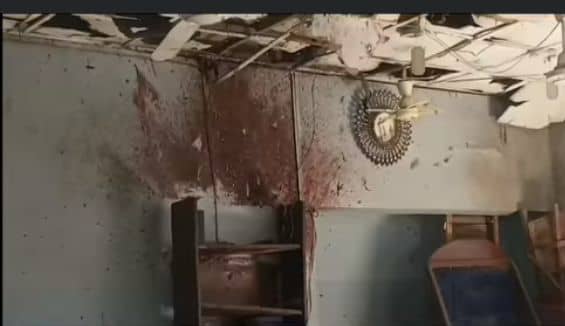At least 1.2 million people in Nigeria are at risk of being blown up by explosive mines – already these have killed 789 civilians and wounded 1,356 others in northeast Nigeria.
Matthias Schmale, the United Nations resident and humanitarian coordinator in the country, said the states most affected were Borno, Adamawa and Yobe.
He was speaking at an event to mark this year’s International Day for Mine Awareness and Assistance in Mine Action on Monday, April 4.
Schmale, who works with the United Nations Relief and Works Agency, said those at risk were identified during this year’s Humanitarian Needs Overview process.
“Explosive ordinance in their different forms continue to represent immediate, grave and additional threats to the populations in northeast Nigeria,” he said, adding that there had been 1,532 incidents in the region involving explosive hazards from January 2016 to January this year.
Unexploded ordnance, unexploded bombs and explosive remnants of war are explosive weapons – bombs, shells, grenades, land mines, naval mines, cluster munition and other munitions – that that did not explode when they were employed and still pose a risk of detonation.
These included bombs, warheads, mines, rockets and all similar or related items or components explosive in nature, including improvised explosive devices, commonly found in northeast Nigeria.
RNI reporter Nana Hadiza Mustapha spoke to a woman who lost her mother in a mine blast.
Fati Umar said: “My mother was among those who were victims of an explosive device in Monday Market in Maiduguri on March 7, 2015. We were going to a wedding when she said she had to buy something in the market. She told me to go on and that she would meet me at the house. After a while, I heard the news that a device had exploded inside the market. I was terrified and extremely anxious because I knew my mother was there.
“I tried to go and check but people stopped me, telling me my mother was fine. I was still very worried and so I left the wedding without anyone seeing me and called my sister. She said she had not heard anything from our mother.”
Umar said she and her sister cried a lot because their mother’s phone “just rang and rang” and there was no answer.
“My husband came to pick me up and he also kept trying her number but she did not answer. It was only when we reached our house that I saw many people gathered. Then I knew something bad had happened. I ran to see what had happened and that was when I was told my mother had died in the explosion. It was the worst day of my life.”
She said her father refused to remarry until they had insisted he did so because he was not doing well on his own. Unfortunately, that marriage did not last.
“My father told us we should leave him alone. To this day he cannot get over my mother’s death. He still misses her terribly. We all do.”
- The Mines Advisory Group (MAG), a global humanitarian and advocacy organisation, finds, removes and destroys landmines, cluster munitions and unexploded bombs from places affected by conflict. The organisation has been at the forefront of a developing humanitarian crisis in northeast Nigeria since April 2017.
In a recent report, MAG said locally manufactured anti-personnel landmines have been deployed on roads, in fields and also in urban areas. In addition, MAG and other organisations have encountered unexploded rocket-propelled grenades, projectiles, mortars, grenades and air-dropped weapons.
MAG’s data shows that the casualty toll from explosive ordnance is high and relentlessly rising.
Locally manufactured improvised explosive devices (IEDs) have been used extensively by the Jamā’at Ahl as-Sunnah lid-Da’way Wa’l-Jihād (JAS), more commonly known as Boko Haram, and other insurgents and they make up the majority of devices recorded by MAG.
The coronavirus pandemic has hampered and disrupted humanitarian organisations’ efforts to reach affected communities with lifesaving risk education and lockdown measures have exacerbated the poor access to services.
MAG said explosive ordnance pose a dangerous threat to the many internally displaced persons (IDPs), refugees and returnees transiting throughout the region.
As IDPs and refugees migrate or return home – often through unfamiliar terrain – they are at significant risk of entering areas contaminated by landmines and other explosive ordnance.
Returning to villages that are contaminated by explosive ordnance put returnee communities at risk and also limits the degree to which they can begin rebuilding homes and livelihoods, MAG said.
These hazards also represent a substantial threat to the safety and security of humanitarian workers trying to mitigate the effects of the conflict for local populations, reducing their access and ability to support vulnerable communities.
MAG said children are extremely vulnerable and that the real number of girls, boys and teenagers killed or injured by landmines and unexploded bombs is difficult to assess.
MAG described an incident that happened in an IDP camp in Borno. The case study tells how nine-year-old Mustapha, who fled from the JAS with his family, lost his life to an explosive device.
His 14-year-old uncle, Bakura, was wounded and rushed to hospital in a critical condition.
The two boys had found a metal object. Oblivious to its danger and thinking they could sell it for scrap, they brought it into the camp where they lived with Falmata, Bakura’s mother.
The device exploded, killing Mustapha instantly and seriously wounding Bakura, Falmata and a neighbour.
Neither boy had any idea about how to recognise dangerous explosives, what to do if you spot one and how to report the discovery.
AISHA SD JAMAL







